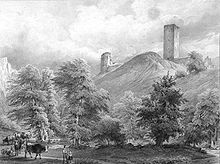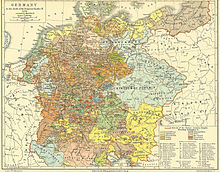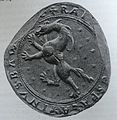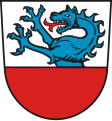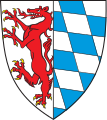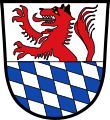Ortenburg (noble family)

The Bavarian Counts of Ortenburg (formerly Ortenberg ) are a dynasty with origins in Rhine Franconia and Carinthia . The Ortenburgers are a side branch of the Spanheimer dynasty , who held the ducal dignity of Carinthia from 1122 to 1269 (nominally until 1279) . The Ortenburgers ruled the Lower Bavarian imperial county of Ortenburg from 1134 to 1805 , an imperial territory, and therefore belong to the high nobility . The family of the Counts of Ortenburg still exists today, the main branch lives in Tambach in Upper Franconia .
In addition to their imperial county, the Ortenburgers had extensive possessions in Lower Bavaria , the Upper Palatinate and Austria . In addition, they were the bailiffs of the Passau bishopric , the cathedral chapter of Passau, as well as the monasteries of St. Nikola , Aldersbach , Frauenchiemsee and Mondsee .
The county of Ortenburg in Carinthia, however, belonged to a family of the same name, which died out in 1418, of a different tribe and coat of arms. In the generations-long Ortenburg inheritance dispute , however, the Bavarian Ortenburgers later claimed the Carinthian heritage.
history
The origin of the sex lies in Rhineland-Palatinate . Ancestor was Siegfried I von Spanheim . In 1044 he appeared as the ruling Count of Sponheim . By marrying Richgard, the heir to Count Engelbert IV. In the Pustertal from the Sieghardinger family , he acquired large estates in Tyrol and Carinthia . In 1048 he appeared as Gaugraf in Pustertal and Graf in Lavanttal . He also took over his father-in-law's possessions in Upper Bavaria.
His grandson, Engelbert II. Von Kraiburg , who later became Duke of Carinthia, enlarged it to include extensive estates in Upper and Lower Bavaria, which he divided among his sons, due to his marriage to the wealthy heir daughter Uta von Passau , daughter of Ulrich the Rich . Engelbert III. received large areas in Chiemgau and Rottal , while his brother Rapoto I inherited extensive estates north of Kraiburg .
That Rapoto became the progenitor of the side branch of the Spanheimers: From 1134 he called himself Graf von Ortenberg (after the old name of Ortenburg ). After Engelbert III. had died childless in 1173, Rapoto fell to the county of Kraiburg -Marquartstein. The holdings of the House of Ortenburg stretched from Tirschenreuth in the Upper Palatinate over the counties of Ortenburg, Kraiburg and Murach in a wide arc to Kitzbühel in Tyrol . From then on, this was to form the heartland of the Ortenburg counts for about 130 years. After Rapoto's death in 1186, his possessions fell to his two sons Rapoto II von Ortenburg and Heinrich I. They divided up their father's possessions, Rapoto II got the county of Kraiburg-Marquartstein and the possessions in Chiemgau and south of it, Heinrich I. the county of Ortenburg and the county of Murach. The territories were not reunited after the division.
The Kraiburg Count Palatine of Bavaria

In 1208 became Rapoto II. The Palatine dignity . Thus he became the deputy of the emperor and the duke in the Duchy of Bavaria . He carried out his office from Kraiburg. Together with his brother Heinrich, he was involved in several conflicts with the neighbors, the Bishops of Passau , the Dukes of Bavaria and Austria and the King of Bohemia . Duke Ludwig I of Bavaria, Rapotos II's brother-in-law, invaded the Kraiburg region in 1199 and destroyed the ancestral castle Kraiburg, which Rapoto had rebuilt after the conflict had been resolved.
In 1231 Rapoto II died and his office and dignity fell to his son Count Palatine Rapoto III. from Ortenburg. Under his rule, the Kraiburg Count House was at the zenith of its power. The possessions stretched from the Danube over large parts of the Rottal to the right bank of the Inn , from the Alz to the Traun and from the south of the Chiemsee to the Brixental . Furthermore, he had large fiefs in the Salzburg area from the local bishops . The county area was secured by the castles Kraiburg, Trostberg , which Rapoto III. In 1232, Massing , Dachberg, Rotenberg and Griesbach were built . Until the death of the second Count Palatine Rapoto III from Ortenburg. in 1248 the Ortenburg house was one of the most powerful Bavarian aristocratic houses. Their possessions ranged from Brixental and Kitzbühel over a wide arc across the eastern Bavarian region, up to Tirschenreuth in the Upper Palatinate and were thus even larger than those of the Wittelsbachers . The Ortenburgers managed their possessions independently to the extent that they were well on the way to making their territories independent of the Duchy of Bavaria and to become an independent duchy. This led to repeated conflicts with the neighbors. After the death of Rapotos III. In 1248 and the associated loss of the County of Kraiburg, the Ortenburgers lost most of their power. He had only one daughter, who married Hartmann I von Werdenberg , who took over the possessions and the entire possessions of the former Ortenburg-Palatinate Count's house in 1259 to the Wittelsbach Duke Heinrich XIII. sold by Niederbayern .
The Ortenburg counts


Heinrich I and his older brother Rapoto II received the estates in the Nordgau with Murach near Oberviechtach as well as the county of Ortenburg in Wolfachtal with its seat in Ortenburg including some estates in the Rottal. In 1206 he founded the city of Vilshofen on the Danube together with the Bishop of Passau . A document from Emperor Frederick II from 1229 granted him the operation of mines, thus transferring regalia , which is considered to be the nucleus for the later imperial immediacy of the County of Ortenburg. Heinrich's possessions expanded considerably in 1223 and 1232 when Diepold von Leuchtenberg , the Lords von Höhnberg and Heinrich von Altendorf (from the house of the Counts of Leonberg) pledged rich possessions to him. These included the Leuchtenberg fortress , possessions in Höchstadt an der Aisch and Pfaffenhofen Castle in the Nordgau, as well as possessions around Mühlbach, Neustadt and Neumarkt . His possessions stretched from the Rottal up to Tirschenreuth along the Bohemian border.
Inheritance disputes and loss of territory
In 1238 Heinrich I gave the county of Murach to his younger sons from his second marriage, Gebhard , Diepold and Rapoto IV, and their mother Richgard von Hohenburg, which made his eldest son from his first marriage, Heinrich II , bitter. As a result of him, the Ortenburg line later almost completely lost its property and reputation. In 1241 he succeeded his father Heinrich I as Count von Ortenburg , but wanted with all his might to prevent his half-brothers from coming to his estates. He even tried to forcibly bring Richgard and his stepbrothers into his hand, so that even the emperor would issue them a letter of protection. Richgard soon fled to her relative, Duke Otto II of Bavaria. He broke into the Ortenburg possessions with armed force in 1241 and annexed Vilshofen . Heinrich fled from Otto II to the Bishop of Passau. This granted him accommodation, and in return, Heinrich gradually gave him more and more goods from his possessions. In 1248 Heinrich fled to Bamberg . He bequeathed all of his fiefs and possessions to the local bishop in return for an annual pension of 50 pounds Bamberg pfennigs. The Ortenburg house lost almost all of its possessions except for the castles Murach and Ortenburg, which Duke Otto had still occupied. The remaining county was therefore only as big as the Ortenburg market before the Bavarian municipal reform of 1972.
The Ortenburgers temporarily gave up their imperial rights under Georg I and Etzel I in 1391 , whereby the counts were vassals of the dukes of Bavaria at that time . Over the centuries, these concessions were to serve as a justification for the Bavarian dukes to incorporate the county. However, they did not succeed in this despite the serious concessions and the associated partial abandonment of imperial rights. Although the county was temporarily a Bavarian vassal, it did not become a Bavarian market town until 1805. By entering into the 1521 Reichsmatrikel and the Imperial Court judgment of 1573 succeeded his descendants, to break away from the former concessions to the Bavarian dukes again.
Resurgence
The reputation and power of the Ortenburgers rose again until 1551. Sebastian I had inherited the imperial county of Neuburg with Neuburg am Inn from his father-in-law Johann von Rohrbach , who had been Count of Neuburg since 1463 . Emperor Friedrich III. however, saw the county as a fallen fiefdom and occupied it in 1467. However, Sebastian I managed to capture the castle and withstand a subsequent siege. Only through the mediation of Duke Ludwig IX. von Bayern-Landshut came to a settlement at the Reichstag in Augsburg in 1473 , whereby the count received a settlement of 4,000 guilders for the return of the county of Neuburg. Furthermore, the imperial immediacy of the county of Ortenburg was confirmed again. Sebastian I was the bride's chamberlain at the Landshut wedding in 1475 . His son, Count Christoph I , soon belonged to the richest gentlemen in Lower Bavaria again , through his marriage to Anna Hollup, heir to the Bohemian knight Friedrich von Hollup at Mattighofen Castle and Neudeck Castle .
Mattighofen Castle and Mattighofen Market (1721)
Neudeck Castle (1723)
In 1530, due to the Ortenburg inheritance dispute with Count Gabriel von Salamanca-Ortenburg over the Carinthian County of Ortenburg , Count Christoph renamed the Lower Bavarian family, previously mostly named Ortenberg , to Ortenburg , equal to the extinct Carinthian family. The dispute over the alleged Carinthian heritage would drag on for centuries. In 1538 Christoph and his second wife converted to the evangelical confession.
Conversion to the Protestant faith and conflicts with Bavaria



In 1551 Christoph's son Joachim became the ruling count. In the course of time he became an avowed supporter of Lutheran teaching. At the Reichstag in Augsburg in 1555, Joachim stood up for the Augsburg confession and for the Protestant side. He officially introduced the Protestant faith in his county in 1563 . This was the trigger for the so-called " Ortenburg aristocratic conspiracy " , which led to a dispute with the Bavarian dukes that lasted for decades. In particular, Duke Albrecht V , whose adjutant the Bavarian estates elected Joachim in 1555, turned from a friend into a bitter enemy of the count. The conflict weakened the Ortenburgers immensely. In 1563 Albrecht V had the two Ortenburg festivals Alt- and Neu-Ortenburg opened and occupied, in 1564 Mattighofen too; in addition, the duke confiscated all Bavarian fiefs and properties of the Ortenburgers. In order to prevent the further spread of the faith, Albrecht V blocked all entrances to the imperial county. However, this measure was only partially successful, as the Bavarian population tried even more to get into the county in order to follow Luther's teaching there. Joachim himself remained persistent and did not change his views. At the Reichstag in Augsburg in 1566, the Protestant imperial princes stood up for Joachim and his county, so that a settlement was reached. The trials and blockades ruined Joachim, however, and he also saw that the dukes would never give up their efforts to incorporate the imperial county. For this reason, he created in 1566 together with his two cousins Ulrich III. and Johann III. a new law of inheritance. The seniorate succession for the Reichsgrafenamt, which had been in effect orally since the 13th century, was legally stipulated. Joachim also had his law confirmed by Emperor Maximilian II. This secured the continuation of the line of succession of the House of Ortenburg in the event that a branch of the family died out. On the mediation of Joachim's brother-in-law, Count Hans Fugger , sales talks were held with the Duchy of Bavaria in 1589 and 1590. The county of Glatz , which belongs directly to Bohemia, was intended as an object of exchange for the county of Ortenburg, which was acquired by pledge from Duke Ernst of Bavaria in 1549 for 140,000 guilders and fell to Albrecht V in 1560 . However, there was no exchange. From the Imperial Court Imperial City was in 1573 again confirmed d. H. the county of Ortenburg remained free of the empire and independent of its large neighbor Bavaria until its end. The Bavarian Duke was condemned to remain silent on this matter, as this conflict had been smoldering since 1391, the time of George I von Ortenburg . Joachim died in Nuremberg in 1600, deeply in debt.
In the 17th century, the Ortenburgers were initially only formally counts, as the county was pledged to Joachim's widow and heir after Joachim's death. In 1628, Count Friedrich Casimir tried to redeem the imperial county and the two castles. But due to his lavish lifestyle and his enormous expenditure on art (he also worked as a painter), he did not manage to raise the required 25,000 guilders and was only able to redeem the family castle Alt-Ortenburg. It was only his successor, Count Georg Reinhard, and his brother Christian who jointly managed to redeem the county in 1662, after 61 years. During the Thirty Years' War the noble family stood on the side of the Duchy of Bavaria. The reason for this was that the two brothers, like their father Georg IV. In 1612, had at least formally changed to the Catholic faith in order to protect themselves from further conflicts with their Bavarian neighbors, to gain well-paid court posts and to regain their county trigger. In return, they got their Bavarian fiefs back, with the exception of the rich Mattighofen rule . However, the evangelically married Georg Reinhard had his children raised in the Protestant faith again, much to the displeasure of his childless brother Christian, so that the following generations of the Ortenburgers became Protestants again. Under Count Georg Philipp (1655–1702) there was a conflict with the Ortenburg population about high tax burdens.
Exchange of Ortenburg against Tambach


After the county and the family had survived the Napoleonic wars as neutral, Count Josef Carl exchanged the county for the county of Ortenburg-Tambach in 1805 due to the high debt of his family . Since his extravagant mother had left him heavy debts, he began - as the third of his family after Georg I and Joachim - sales negotiations over the county. In negotiations with the Electorate of Bavaria on February 28, 1804, an agreement was reached on the sale of Ortenburg and all of the count's possessions in Bavaria. In return, the count received the promise to receive a Frankish rule, to be named, and the elector undertook to take over the debts of Joseph Carl. In March 1805, Elector Maximilian IV presented the former Tambach monastery office on the border to the Duchy of Saxony-Coburg-Gotha , which came from secularized goods, as an object of exchange. The barter agreement was signed on August 14, 1805. The monastery became the imperial county of ortenburg-Tambach Charge but already on 25 September 1806 by the Electorate of Bavaria mediated . The count was thereby downgraded to a rank lord. Joseph Carl tried at the Congress of Vienna , like many other mediatized princes and counts, to regain his lost sovereign rights, but without success. In 1818 a new constitution was introduced in Bavaria by Maximilian I. This also provided for compensation for the landlords, through which Joseph Carl received a cash payment and a hereditary seat in the Chamber of Imperial Councils .
The Ortenburg family has lived at Tambach Castle near Coburg since 1805 . In 1827, however, Count Josef Carl repurchased the original seat, the Ortenburg Castle , which was threatened with demolition , from the Bavarian crown - against the payment of compensation owed. It was not until Alram Graf zu Ortenburg auf Tambach (1925–2007), who again converted to Catholicism, sold the Ortenburg Palace to a local hotelier in 1971. His eldest son Heinrich (* 1956) inherited Tambach and is the current head of the Ortenburg family, his prospective successor is his eldest son Carl-Theodor (* 1992) from his marriage to Désirée Princess of Hohenzollern (* 1963, daughter of Johann Georg von Hohenzollern and Princess Birgitta of Sweden ). Alram's younger brother Aurel Ladislaus Franz (1927–2001), who remained Protestant, took over the Lower Franconian Castle of Birkenfeld , inherited from the Barons von Woellwarth in the 19th century ; Through his wife, Countess Isabelle von Aldenburg- Bentinck (1925–2013), the last heiress of the German-Dutch branch of this important count's house, parts of the Swabian former noble lordship Waldeck-Limpurg and the Dutch Middachten Castle near Rheden in Gelderland came to this branch of the family Ortenburgs; Middachten was taken over by son Franz (* 1953), Birkenfeld by son Philipp (* 1955).
The Ortenburgstraße in Munich and Oberviechtach and the Ortenburgerstraße in Mattighofen are named after the gender . Furthermore, in 1966 the Ortenburg-Gymnasium was named in memory of the earlier Counts of Ortenburg-Murach after the counts.
The lines of the House of Ortenburg and their possessions
The count's house of the Ortenburgers was divided into several lines in the course of its almost 900-year history. Likewise, these lines divided the holdings of the imperial county of Ortenburg among themselves. Some lines became extinct over the centuries. The names of the different lines were derived from the castle or palace in which they mainly stayed. Some terms were therefore used several times when, after a line had expired, it was later split off again.
In the family there has been an unwritten law since the 13th century that the incumbent imperial count should only be the oldest living count of a line, so it is a seniority principle . In 1566, Count Joachim also introduced this regulation as a binding house law to prevent the county or other possessions from being lost in the future. With this regulation, the county was represented externally by only one count. This meant that the office of the imperial count changed several times between the lines.
Medieval lines
Ortenburg
The line of origin of the Counts of Ortenburg was founded by Rapoto I. from the Spanheim family . He founded the county of Ortenburg around 1120 and probably also built the ancestral castle of the counts above the village, on a strategically favorable hill above the Wolfach valley . After his death in 1186, the first division took place. The eldest son Rapoto II took the possessions in Chiemgau and Rottal and became the incumbent Count of Kraiburg . Rapoto's youngest son Heinrich I continued the Ortenburg line. This received the property north of the Rottal and in the Upper Palatinate .
The Ortenburg County shrank rapidly after Heinrich's death due to internal and external influences. This remaining small county, however, should be the heartland for the county and belong to the Ortenburgers for over 500 years.
The original line of the Ortenburgers split into three lines with the death of Heinrich IV in 1395 as a result of his children. His son Etzel I got the Alt-Ortenburg castle and the market, Georg I got the Neu-Ortenburg castle and its possessions and Alram I got the castle and the village of Dorfbach near Ortenburg. Soon after, these three brothers named themselves after their possessions. The county was also partially divided.
Kraiburg-Ortenburg
With the death of Rapotos I in 1186, his eldest son received the rich county of Kraiburg. This was split off from the county of Ortenburg and became an independent county. Rapoto II continued to promote trade and expand his political power. So it happened that in 1208 he was awarded the title of Count Palatine of the Duchy of Bavaria. He continued to carry out his office at Kraiburg, from which the county and his family benefited immensely. When Rapoto II died in 1231, his son Rapoto III. the dignity of the Count Palatine. Under him the Kraiburg house reached its greatest power. The wealth of the house grew and the county reached its greatest extent. However, Rapoto III. only one daughter and thus this line of the Ortenburg family died out in 1248 with his death and the property fell to the husband of his daughter Hartmann I von Werdenberg , who sold them to the Wittelsbach family in 1259 . The Ortenburg counts tried in vain to get hold of the property of this line.
15th century lines
After the death of Count Heinrich IV in 1395, there were large divisions of the estate. The house was divided into the three lines Alt-Ortenburg, Neu-Ortenburg and Dorfbach.
Alt-Ortenburg
Etzel , Heinrich's son, received the ancestral castle Alt-Ortenburg and the associated market Ortenburg. He initially ruled the imperial county together with his older brother Georg I and after his death in 1422 even became the incumbent Count of Ortenburg. Etzel and his brother temporarily downgraded the county to a vassal of the Duchy of Bavaria-Landshut , as neither of them could resist the overpowering Bavarian duke.
Etzel died in Straubing in 1446. However, since he only had one daughter, the Alt-Ortenburg line died out with him. Thanks to the Ortenburg inheritance regulations, his possessions fell back to the House of Neu-Ortenburg.
Neu-Ortenburg
Heinrich's son Georg I received Neu-Ortenburg and the property belonging to it. Georg ruled together with his brother Etzel until the end of his life. However, both could not prevent the county from being forced to become a vassal of the dukes of Bavaria-Landshut at that time.
Georg's line was to develop over the course of this century as the main line of the Ortenburg counts. After the other two Ortenburg lines died out in 1446 and 1461, all possessions of this line fell to. By the middle of the 16th century, the Neu-Ortenburg house managed to break free of the Wittelsbacher clutches over time . The introduction of the Reformation in Ortenburg in 1563, however, led to another conflict with Bavaria.
Dorfbach

Heinrich's son Alram I fell to the Dorfbacher possessions. These were already part of the imperial county, but were given as fiefs. With Alram's marriage in 1381 to the rich widow Barbara von Rottau and the renunciation of the next of kin of her deceased husband, these rich estates fell back to the Ortenburgers' house. He gave up other areas after his father's death. Since then, Alram I. Graf zu Ortenburg called himself , sat at Dorfbach . After the death of his son Alram II in 1461, the Dorfbach line died out and the possessions fell to the Neu-Ortenburg line.
Subdivision of the House of Neu-Ortenburg since the 16th century
After the death of Count Georg II († 1488) and his stepbrother Sebastian I († 1490), there were no large divisions of the inheritance. Rather, in the 16th and 17th centuries, the counts administered the estates together for the most part. The lines were also no longer named directly after their residences.
In principle, two branches were formed, the Graf Christophs family based in Alt-Ortenburg and Mattighofen , and the Graf Ulrichs II family with their possessions at Söldenau Castle and Saldenburg .
After Joachim's death in 1600, Count Henry VII and George IV divided the estates among themselves. The county itself was pledged, but Georg received the possessions around Neudeck Castle , while Heinrich received the possessions around Söldenau.
When the county was released in 1662 by Count Georg Reinhard and Christian, there was a new distribution of property. Georg Reinhard received Schloss Alt-Ortenburg, Christian Neu-Ortenburg. After Christian's death in 1684, the property fell to Georg Reinhard's son Georg Philipp , who was able to unite all of the Ortenburg possessions for the first time. To prevent further divisions of inheritance, he wrote the law that everything belongs to the ruling count and the entire count family. From then on there was no further splitting of the Ortenburg possessions until 1805, the end of the county.
Despite the different family lines, the seniority principle was still adhered to. Today the main line of the count's house lives in Tambach near Coburg .
Burial places
The count's family had two graves during their reign in Lower Bavaria. In 1288, Count Rapoto IV designated the Sixtus Chapel at Passau Cathedral as the burial place of the Count's House, since his father and grandfather were already buried there; it is therefore also called the “Ortenburg Chapel”. All Catholic family members were buried there; the last burial took place in 1684 with Count Christian .
In 1573 Count Joachim built a new crypt in the Marktkirche in Ortenburg. All Protestant family members were buried there until the count's family moved away in 1805.
Sixtus Chapel (Passau) (Ortenburg Chapel) with the high grave of Count Heinrich IV.
Count Joachim's cenotaph in the Marktkirche (Ortenburg) from 1576/77
Count Antons cenotaph from 1574/75 in the market church
Epitaph Count Johann Georgs in the market church
coat of arms
Family coat of arms
Blazon : The family coat of arms of the Ortenburgers shows a slanting silver pinnacle bar on a red background; on the helmet with red and silver covers a closed black flight sprinkled with golden linden leaves.
Explanation: Due to various inheritance disputes , it was changed several times before it was adopted in its original form in the middle of the 19th century.
Blazon: The coat of arms of the Count Palatine of Bavaria shows a blue, fire-breathing panther on a silver background.
Explanation: The Count Palatine of Bavaria are an early Kraiburg branch of the House of Ortenburg. The coat of arms was adopted by the Wittelsbachers after the line died out in 1248 . Today it is part of the state coat of arms of Bavaria and stands for old Bavaria .
Family coat of arms of the Graffen von Ortenberg, Bavaria , in Scheibler's coat of arms , from 1450 to 1480
Coat of arms of the Palatine Kraiburger side branch of the House of Ortenburg with a blue panther
The Ortenburg panther in the seal of the Count Palatine Rapoto III. of Bavaria , 1247
Honored coats of arms
Increased coat of arms of the Graffen zu Ortenburg, coat of arms book of the Churbayrischen nobility, 1560
Increased coat of arms of the Graven von Ortenburg , after Siebmacher , 1772
Erbanspruchwappen Ortenburg with coats of arms of the counties Sternberg and Ortenburg in Carinthia and the count's coat of arms to places castle in Bavaria, after Siebmacher , 1605
Erbanspruchwappen without Wappenzierde with coats of arms of the counties Sternberg and Ortenburg in Carinthia and the count's coat of arms to places castle in Bavaria, after Siebmacher , 1605
Large Ortenburg claim coat of arms without coat of arms decoration after the extinction of the Counts of Krichingen and Püttingen, after Tyroff , 1821
Municipal coat of arms with elements of the Ortenburg coat of arms
The heraldic figure of the (blue) Ortenburg panther of the Count Palatine of Bavaria can be found today in the Bavarian state coat of arms for Old Bavaria and thus stands for the two administrative districts of Upper and Lower Bavaria . In many Bavarian town and town coats of arms the panther is shown in red instead of blue.
Coat of arms of the former Oberviechtach district
Elements in the current coat of arms of the Egglham community
Coat of arms of today's Ortenburg market
Alternating battlements as a coat of arms of the Stammham community
Coat of arms element of the Gottfrieding community
Blue Ortenburger Panther in the coat of arms of the district of Traunstein
Blue Ortenburger Panther as an element of the coat of arms of the city of Neumarkt-Sankt Veit
Blauer Ortenburger Panther in the coat of arms of the city of Ingolstadt
Head of the blue Ortenburg panther in the coat of arms of the market in Grassau
Red panther in the coat of arms of the Lower Bavaria administrative district
Ortenburger panther depicted in red in the coat of arms of the city of Vilsbiburg
Red panther as part of the coat of arms of the Rottal-Inn district
Red panther as part of the city arms of parish churches
Red panther as an element of the coat of arms of the city of Eggenfelden
Red panther in the former coat of arms of the Griesbach district
Red panther as an element of the coat of arms of the former Vilshofen district
Ortenburger Panter in the city arms of Vilshofen on the Danube
Green panther in Heldenstein's coat of arms for comparison: it used to be assumed that it was derived from the coat of arms of Styria.
Personalities

- Etzel († May 17, 1446), Chamberlain to King Charles VI. of France .
- Ulrich I von Ortenburg († November 19, 1455), Provost of Passau, Canon of Passau and Archdeacon of Mattsee
- Moritz († July 6, 1551), Bavarian politician and Councilor of the Dukes of Bavaria
- George III († May 7, 1553), Provost of Freising, Canon of Freising, Augsburg and Salzburg and imperial councilor
- Joachim I († March 19, 1600), introduced the Reformation in Ortenburg in 1563 and successfully asserted himself against the Bavarian dukes in the fight for the imperial immediacy of his county
- Henry VIII († August 29, 1622), combatant in the Thirty Years War
- Amalia Regina († April 15, 1709), introduced compulsory schooling in Ortenburg in 1703
- Alram Karl († August 6, 2007), patron saint of Tambach Castle
See also
- List of German noble families
- Imperial County of Ortenburg
- Spanheimer
- List of the dukes of Carinthia
- County of Sponheim
- List of Bavarian noble families
literature
- Förderkreis Schloss Ortenburg (ed.): Ortenburg - Reichsgrafschaft and 450 years Reformation (1563-2013) . Ortenburg 2013.
- Walter Fuchs: Ortenburg Castle, Ortenburg monuments and the history of the imperial county of Ortenburg . Ortenburg 2000.
- Rudolf Endres: Ortenburg, Grafen zu .. In: New German Biography (NDB). Volume 19, Duncker & Humblot, Berlin 1999, ISBN 3-428-00200-8 , p. 596 f. ( Digitized version ).
- Genealogisches Handbuch des Adels , Volume 119, 1999, Adelslexikon .
- Richard Loibl : The rulership of the Counts of Vornbach and their successors, studies on the history of rulership in Eastern Bavaria in the High Middle Ages , Historical Atlas of Bavaria , Altbayern Row 2, Book 5, Munich 1997.
- Markus Lorenz: Ortenburger Geschichtsblätter - The transition of the county of Ortenburg to Bavaria in 1805 . Issue 2, Grießbach im Rottal 1997.
- Franz Mader : Tausend Passauer - Biographical Lexicon on Passau's city history . 1st edition. Neue-Presse-Verlags-GmbH, Passau 1995, ISBN 3-924484-98-8 , p. 169 (co-editor: City Archives Passau).
- Friedrich Hausmann : The Counts of Ortenburg and their male ancestors, the Spanheimers in Carinthia, Saxony and Bavaria, as well as their branch lines . In: Ostbairische Grenzmarken - Passauer Jahrbuch für Geschichte, Kunst und Volkskunde . No. 36, Passau 1994, pp. 9-62.
- Heinz Pellender: Tambach - from Langheim monastery office to Ortenburg'schen Grafschaft - history of the Count's House of Ortenburg, the monastery office and Tambach Castle . 2nd edition, Coburg 1990.
- Wilfried Hartleb: The Evangelical Lutheran school system in the imperial county of Ortenburg from the introduction of the Reformation in 1563 to the takeover of the county by Bavaria in 1805 , (Writings of the University of Passau. Series Geisteswissenschaften, Volume 9) Passau 1987.
- Ina-Ulrike Paul: Ortenburg, Count of. In: Karl Bosl (ed.): Bosls Bavarian biography. Pustet, Regensburg 1983, ISBN 3-7917-0792-2 , p. 563 ( digitized version ).
- Friedrich Hausmann: Archive of the Counts of Ortenburg - documents of the family and the county of Ortenburg, Volume 1: 1142-1400 . Neustadt an der Aisch 1984.
- Hans Bleibrunner: Lower Bavaria - cultural history of the Bavarian lowlands . Volume 1 & 2, 2nd edition, Landshut 1982.
- Hans Schellnhuber , Heinz Hans Konrad Schuster, Friedrich Zimmermann: 400 years of Evang.-Luth. Kirchengemeinde Ortenburg 1563–1963 . Ortenburg 1963.
- Hans Schellnhuber: Of war and strife in the old days - Ortenburg's war events. In: From Ortenburgs Past , Issue 1, Ortenburg 1959, pp. 3–11.
- Eberhard Graf zu Ortenburg-Tambach: History of the imperial, ducal and counts' entire house of Ortenburg - Part 1: The ducal house in Carinthia. Vilshofen 1931
- Eberhard Graf zu Ortenburg-Tambach: History of the imperial, ducal and counts 'entire house of Ortenburg - Part 2: The counts' house in Bavaria. Vilshofen 1932.
- Carl Mehrmann: History of the Evangelical Lutheran community of Ortenburg in Lower Bavaria - memorandum for the anniversary celebration of the 300th anniversary of the introduction of the Reformation there on October 17 and 18, 1863 . Landshut 1863 ( digitized ).
Individual evidence
- ↑ Erich Mathieu: On September 30th, the Ortenburg-Gymnasium in Oberviechtach was inaugurated in the presence of numerous distinguished guests of honor. In: Heimat-Chest, issue 9/10, pp. 1–8.
- ^ Johann Bösl: On the history of the Counts of Ortenburg-Murach. In: 25 Years of Ortenburg-Gymnasium, Oberviechtach 1989, pp. 68–92.
- ^ Georg Lang: The Ortenburgers - namesake for the grammar school in Oberviechtach. In: Die Oberpfalz, Volume 99, Kallmünz 2011, pp. 33–36.
